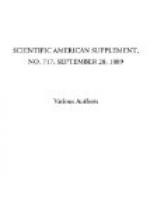We want a certain range of oscillation, between 7,000 and 4,000 billion vibrations per second; no other is useful to us, because no other has any effect upon our retina; but we do not know how to produce vibrations of this rate. We can produce a definite vibration of one or two hundred or thousand per second; in other words, we can excite a pure tone of definite pitch; and we can demand any desired range of such tones continuously by means of bellows and a keyboard. We can also (though the fact is less well known) excite momentarily definite ethereal vibrations of some million per second, as I have explained at length; but we do not at present seem to know how to maintain this rate quite continuously. To get much faster rates of vibration than this we have to fall back upon atoms. We know how to make atoms vibrate; it is done by what we call “heating” the substance, and if we could deal with individual atoms unhampered by others, it is possible that we might get a pure and simple mode of vibration from them. It is possible, but unlikely; for atoms, even when isolated, have a multitude of modes of vibration special to themselves, of which only a few are of practical use to us, and we do not know how to excite some without also the others. However, we do not at present even deal with individual atoms; we treat them crowded together in a compact mass, so that their modes of vibration are really infinite.
We take a lump of matter, say a carbon filament or a piece of quicklime, and by raising its temperature we impress upon its atoms higher and higher modes of vibration, not transmuting the lower into the higher, but superposing the higher upon the lower, until at length we get such rates of vibration as our retina is constructed for, and we are satisfied. But how wasteful and indirect and empirical is the process. We want a small range of rapid vibrations, and we know no better than to make the whole series leading up to them. It is as though, in order to sound some little shrill octave of pipes in an organ, we are obliged to depress every key and every pedal, and to blow a young hurricane.
I have purposely selected as examples the more perfect methods of obtaining artificial light, wherein the waste radiation is only useless and not noxious. But the old-fashioned plan was cruder even than this; it consisted simply in setting something burning; whereby not the fuel but the air was consumed, whereby also a most powerful radiation was produced, in the waste waves of which we were content to sit stewing, for the sake of the minute—almost infinitesimal—fraction of it which enabled us to see.
Every one knows now, however, that combustion is not a pleasant or healthy mode of obtaining light; but every one does not realize that neither is incandescence a satisfactory and unwasteful method which is likely to be practiced for more than a few decades, or perhaps a century.
Look at the furnaces and boilers of a great steam engine driving a group of dynamos, and estimate the energy expended; and then look at the incandescent filaments of the lamps excited by them, and estimate how much of their radiated energy is of real service to the eye. It will be as the energy of a pitch pipe to an entire orchestra.




